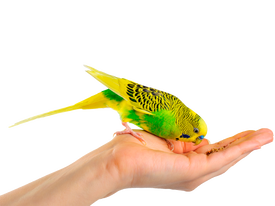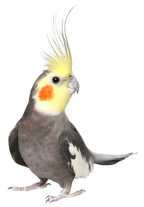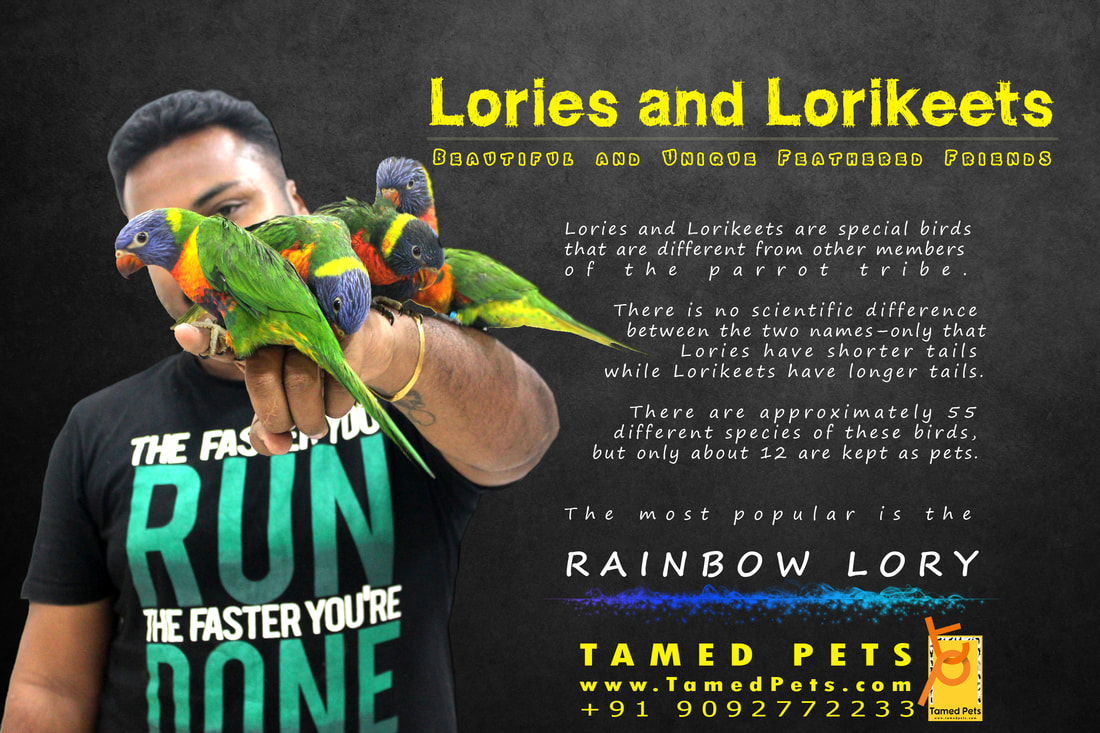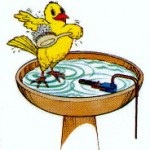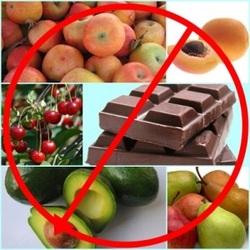If you are thinking of having a pet at home, birds can be a wonderful option. They are Colourful in appearance and surely a beautiful addition to many homes. Their sweet sounds/Singing/human like taling can be a salve to hose with stressed nerves. There are immense varieties of birds in this world. However, not all birds will fare well in an indoor environment. This could be due to their size, their habits or even their state of preservation. It is a pet keepers responsibility to analyse their own requirement and find out if they want to have an indoor pet companion bird or and outdoor aviary bird.
When it comes to having a bird at home, one aspect many don't consider is whether it is part of illegal bird trafficking. Tamed-Pets makes this consideration as well as provide you with list of what are the best birds to keep as pets.
When it comes to having a bird at home, one aspect many don't consider is whether it is part of illegal bird trafficking. Tamed-Pets makes this consideration as well as provide you with list of what are the best birds to keep as pets.
Exotic Birds As Pets.
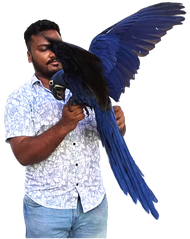
Hyacinth Macaws are the largest bird in the macaw family.
With beauty only nature can create, a life expectancy that often extends far beyond our own, and the ability to immitate/communicate with us in our own language, it is no wonder that the companion bird is fast becoming “man’s best friend.”
Staring roles in movie blockbusters, television commercials, variety shows, and print campaigns ignite the “WOW FACTOR!” in all of us. Before you know it you are headed out to purchase a bird of your own.
Pet Birds make great companions for adults and kids. They keep us healthy, teach responsibility, and form bonds with us that are irreplaceable.
It is very much important to get the facts about pet birds before you choose one. Selecting the bird that is right for you, requires a little bit of time and research. Birds are basically chosen on following priorities.
Staring roles in movie blockbusters, television commercials, variety shows, and print campaigns ignite the “WOW FACTOR!” in all of us. Before you know it you are headed out to purchase a bird of your own.
Pet Birds make great companions for adults and kids. They keep us healthy, teach responsibility, and form bonds with us that are irreplaceable.
It is very much important to get the facts about pet birds before you choose one. Selecting the bird that is right for you, requires a little bit of time and research. Birds are basically chosen on following priorities.
- Colour
- Size
- Sound
- Intelligence
- Imitation/ Talkativeness
- Energy level
- Rarity
- Longevity
Top Few Tamed Companion Birds
BudgerigarBUDGERIGAR are popular around the world, budgies (also known as parakeets) are some of the best pet birds for good reason. When properly tamed and cared for, these birds can be extraordinarily friendly and affectionate. On top of being small and fairly low-maintenance, budgies take well to training and can learn to perform many fun bird tricks, including learning to talk.
Species Overview
LENGTH: 6 to 8 inches WEIGHT: 1 ounce PHYSICAL CHARACTERISTICS: Green abdomen; black and yellow back; yellow head; dark blue tail; mutations include blue, yellow, white, and gray |
CockatielsThe captivating COCKATIEL is another great choice for anyone who wants a friendly and affectionate pet bird. Hailing from Australia, these birds make excellent pets when hand-fed as babies and raised in positive environments. While they don't normally learn to talk, cockatiels are exceptionally intelligent. Many learn to whistle quite well and mimic common household noises, such as doorbells, telephones, and microwaves.
Species Overview
LENGTH: 12 to 13 inches WEIGHT: 3 ounces PHYSICAL CHARACTERISTICS: Gray body; yellow face and crest; orange cheeks; long tail; mutations include albino, lutino, pied, and cinnamon |
African LovebirdsTrue to their name, LOVE-BIRDS thrive in bonded pairs. But a single bird also can do well with an involved caretaker. Lovebirds don't like to be alone and can develop behavioral issues, such as biting, with neglect. They're also fairly vocal, making loud, high-pitched chirps you might not expect from such a small bird. The most common species kept as pets are the Fischer's, black-masked, and peach-faced lovebirds.
Species Overview
LENGTH: 5 to 7 inches WEIGHT: 2 ounces PHYSICAL CHARACTERISTICS: Short tail; somewhat stocky build; many color varieties, including green, blue, peach, yellow, and white; the face and body usually bear different colors |
Lories and Lorikeets...
Blue-Eyed Cockatoo
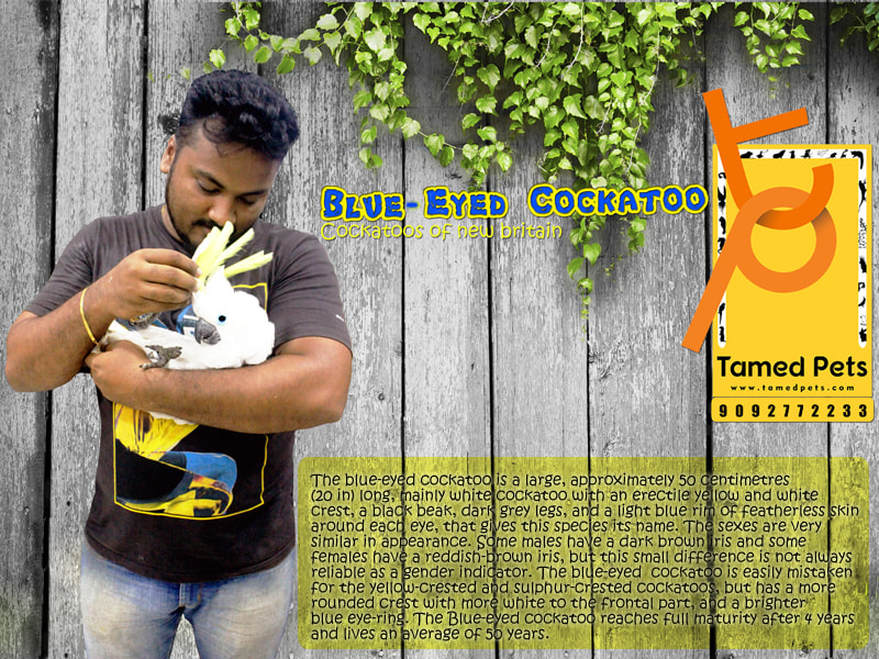 Blue-Eyed Cockatoos - very rare and beautiful birds
Blue-Eyed Cockatoos - very rare and beautiful birds
Blue Eyed cockatoos .....are very rare and beautiful birds which are good as pets when hand raised properly.
If you are interested in possessing this bird as your pet,
Reach us at 9092772233
We operate from Chennai and supply across India.
About Blue-Eyed Cockatoos:
The blue-eyed cockatoo is a large, approximately 50 centimeters (20 in) long, mainly white cockatoo with an erectile yellow and white crest, a black beak, dark grey legs, and a light blue rim of featherless skin around each eye, that gives this species its name. The sexes are very similar in appearance. Some males have a dark brown iris and some females have a reddish-brown iris, but this small difference is not always reliable as a gender indicator. The blue-eyed cockatoo is easily mistaken for the yellow-crested and sulphur-crested cockatoos, but has a more rounded crest with more white to the frontal part, and a brighter blue eye-ring. The Blue-eyed cockatoo reaches full maturity after 4 years and lives an average of 50 years.
*We deal only with Birds and Animals which are legal to possess in India. Also we deal with the captive breeds of exotic pets only and never support any illegal/unethical trades in the same.
If you are interested in possessing this bird as your pet,
Reach us at 9092772233
We operate from Chennai and supply across India.
About Blue-Eyed Cockatoos:
The blue-eyed cockatoo is a large, approximately 50 centimeters (20 in) long, mainly white cockatoo with an erectile yellow and white crest, a black beak, dark grey legs, and a light blue rim of featherless skin around each eye, that gives this species its name. The sexes are very similar in appearance. Some males have a dark brown iris and some females have a reddish-brown iris, but this small difference is not always reliable as a gender indicator. The blue-eyed cockatoo is easily mistaken for the yellow-crested and sulphur-crested cockatoos, but has a more rounded crest with more white to the frontal part, and a brighter blue eye-ring. The Blue-eyed cockatoo reaches full maturity after 4 years and lives an average of 50 years.
*We deal only with Birds and Animals which are legal to possess in India. Also we deal with the captive breeds of exotic pets only and never support any illegal/unethical trades in the same.

Birds as Pets...
Life is a song when there’s a BIRD in it.
Quaking, Singing, chirps, creaching. Soaring. Some even talking,
Whether you are feeding them in your backyard or sharing your nest with a tweety little buddy, you can’t help but love them.
Yes, That’s why we have everything you need to care for your feathered friends, so a real bonding can take flight.
We’ll help them feel home tweet home, with cages of all shapes and sizes and tailored if required .
Healthy treats for when they feel like pecking.
The perfect perches to make them feel proud.
Swings that have them singing for more.
Outdoor companion pets can feel the love with their toys and cages.
And if you have any questions / concerns about your bird or to buy a bird, just sing out.
We’ll help you keep your companion fit and flapping, for years to come.
Life is a song when there’s a BIRD in it.
Quaking, Singing, chirps, creaching. Soaring. Some even talking,
Whether you are feeding them in your backyard or sharing your nest with a tweety little buddy, you can’t help but love them.
Yes, That’s why we have everything you need to care for your feathered friends, so a real bonding can take flight.
We’ll help them feel home tweet home, with cages of all shapes and sizes and tailored if required .
Healthy treats for when they feel like pecking.
The perfect perches to make them feel proud.
Swings that have them singing for more.
Outdoor companion pets can feel the love with their toys and cages.
And if you have any questions / concerns about your bird or to buy a bird, just sing out.
We’ll help you keep your companion fit and flapping, for years to come.
Cost, Noise, Space, Time, Effort, Companionship & Commitment
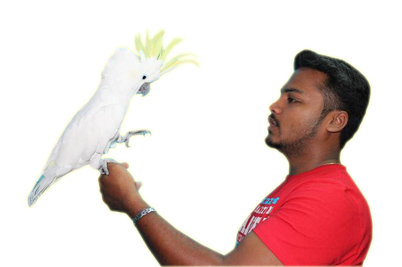
How much do you want to spend for your new pet bird?
A Macaw can be very expensive while parakeets, finches and canaries are much more affordable.
How much noisy do you want your bird to be & how much noise can you tolerate?
Some parrots can be very loud and this could present problems for apartment dwellers. But some can have a very low noise level. Finches and canaries in particular are more sedate and peaceful.
Are you looking for a personal companion or a family pet?
Some parrots prefer a single owner while others like to interact with many people and are more family oriented. The exotic bird you choose will and should depend on what your life style is as well as your personality type.
Can you share your personal/play time with your pet bird?
Many parrots like to be handles and cuddled while finches and canaries do not. Birds are considered to be one of the most intelligent and easy to manage pets. However like humans pets tend to get depressed if they spend too long of a time in a cage with nobody around.
Parrots are social animals in the wild. They roost, fly and forage many times in a flock. This fact helps us understand that parrots need a flock. Your family is the flock for a companion bird. That means they want to be part of family activities. One reason parrots scream is to call the flock. If the family is in one room and the bird is in its cage in another, the bird will scream to get the flock's attention. In the wild they would make the same call to locate the flock, and then fly to join the other members of the "family."
Many species of parrots mate for life. Sometimes this means that a parrot will bond with one person and be aggressive toward another. They are protecting their "mate." Other parrots are more social and will interact with several people. Understanding the behavior of birds in the wild is very important to understanding their behavior as companions.
How much space do you have available for your bird?
Remember that you will need a cage for your new pet bird. Large birds need large cages and large cages can be costly. When keeping birds such as parrots, pigeons, and budgies you need to make sure that the cage is large enough for them to move around them. Many people make the mistake of keeping birds in small cages to save space! this behavior is both cruel and has an adverse affect on the bird’s health.
Most experts believe that your first priority should not to keep birds in a cage for a long time. It’s better to have their wings clipped and hopping around then sitting around in a small cage. It’s also a good idea to keep more than one bird in a cage ideally one male and one female so that they don’t get bored. Make sure that you keep the cage in a place where the bird has good visibility on what is going on around him. Best places will be garden or on the terrace where they might be greenery as well as other birds roaming around.
Think of all the things you will need to house your bird and be prepared for the expense you will incur.
Finally, are you looking for a lifelong commitment?
Remember many parrots will live for 50 years or more, while parakeets have a lifespan of about 8 years.
Make sure you read through http://www.tamedpets.com/index.html before you buy any pet
Each and every bird have their own habbits, traits, attitude and individuality. They are not to be treated like a slave. Only if you have love and affection and if you can respect their individuality, buy/adopt them. If your purpose/love is temporary, fur/plastic/fibre-toys from the market will be the right option for you.
The bottom line is that birds make a wonderful, captivating, and interactive pet. Do you homework before you make your choice.
A Macaw can be very expensive while parakeets, finches and canaries are much more affordable.
How much noisy do you want your bird to be & how much noise can you tolerate?
Some parrots can be very loud and this could present problems for apartment dwellers. But some can have a very low noise level. Finches and canaries in particular are more sedate and peaceful.
Are you looking for a personal companion or a family pet?
Some parrots prefer a single owner while others like to interact with many people and are more family oriented. The exotic bird you choose will and should depend on what your life style is as well as your personality type.
Can you share your personal/play time with your pet bird?
Many parrots like to be handles and cuddled while finches and canaries do not. Birds are considered to be one of the most intelligent and easy to manage pets. However like humans pets tend to get depressed if they spend too long of a time in a cage with nobody around.
Parrots are social animals in the wild. They roost, fly and forage many times in a flock. This fact helps us understand that parrots need a flock. Your family is the flock for a companion bird. That means they want to be part of family activities. One reason parrots scream is to call the flock. If the family is in one room and the bird is in its cage in another, the bird will scream to get the flock's attention. In the wild they would make the same call to locate the flock, and then fly to join the other members of the "family."
Many species of parrots mate for life. Sometimes this means that a parrot will bond with one person and be aggressive toward another. They are protecting their "mate." Other parrots are more social and will interact with several people. Understanding the behavior of birds in the wild is very important to understanding their behavior as companions.
How much space do you have available for your bird?
Remember that you will need a cage for your new pet bird. Large birds need large cages and large cages can be costly. When keeping birds such as parrots, pigeons, and budgies you need to make sure that the cage is large enough for them to move around them. Many people make the mistake of keeping birds in small cages to save space! this behavior is both cruel and has an adverse affect on the bird’s health.
Most experts believe that your first priority should not to keep birds in a cage for a long time. It’s better to have their wings clipped and hopping around then sitting around in a small cage. It’s also a good idea to keep more than one bird in a cage ideally one male and one female so that they don’t get bored. Make sure that you keep the cage in a place where the bird has good visibility on what is going on around him. Best places will be garden or on the terrace where they might be greenery as well as other birds roaming around.
Think of all the things you will need to house your bird and be prepared for the expense you will incur.
Finally, are you looking for a lifelong commitment?
Remember many parrots will live for 50 years or more, while parakeets have a lifespan of about 8 years.
Make sure you read through http://www.tamedpets.com/index.html before you buy any pet
Each and every bird have their own habbits, traits, attitude and individuality. They are not to be treated like a slave. Only if you have love and affection and if you can respect their individuality, buy/adopt them. If your purpose/love is temporary, fur/plastic/fibre-toys from the market will be the right option for you.
The bottom line is that birds make a wonderful, captivating, and interactive pet. Do you homework before you make your choice.
Best First-time Bird & How to Select/Purchase
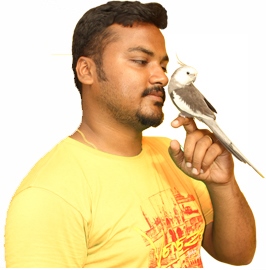
Cockatiels to our knowledge are the best starter/beginners bird if you want to learn what parrots are capable upto. At any given point in time, we have cockatiels for sale in Chennai., Also available for delivery across India. All our Cockatiels are HandRaised and Hand Tamed. They are Well Socialized and Well behaving. We have wide Colour/Mutation range of cockatiels available for you to choose from.
Dial us for availability: +91 9092772233
A fully hand-fed, handraised and socialized cockatiel can become a boon to the family. They step-up, Whistle, Identify people, Welcome tones, Dance, Mimics, loves preening by owners, claimbs on us ., etc .,etc., what not!
Whereas a wing clipped bird doesn't mean they are hand-fed or hand-reard. They are mostly parent raised bird. Some people to be penny wise(*on cost) go for these parent raised birds available in normal animal stores(*we call it this way as they don't treat them as pets) which will always feel insecure and their morale will also be down, which doesn't come to you will always be on their own way and they feel insecure and their morale will also be down.
Always purchase from reliable, authentic places where you get knowledgeable support before & after sale.
*Above selection scenario is the same for other pets also
Dial us for availability: +91 9092772233
A fully hand-fed, handraised and socialized cockatiel can become a boon to the family. They step-up, Whistle, Identify people, Welcome tones, Dance, Mimics, loves preening by owners, claimbs on us ., etc .,etc., what not!
Whereas a wing clipped bird doesn't mean they are hand-fed or hand-reard. They are mostly parent raised bird. Some people to be penny wise(*on cost) go for these parent raised birds available in normal animal stores(*we call it this way as they don't treat them as pets) which will always feel insecure and their morale will also be down, which doesn't come to you will always be on their own way and they feel insecure and their morale will also be down.
Always purchase from reliable, authentic places where you get knowledgeable support before & after sale.
*Above selection scenario is the same for other pets also
Intelligence/Mimicry/Talking ability:
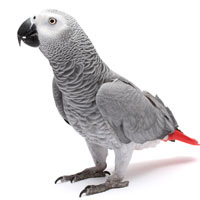
Parrots are very intelligent! Some Macaws, African Greys and Amazons (to name a few) can mimic speech and other sounds they hear in their environment. Some species are better at mimicking than others, but remember that Each and every bird have their own habbits, traits, attitude and individuality. Some soft-billed birds are good at mimicry too.
Dont buy a bird just because you expect him/her to talk.
These parrots have the ability to mimic; which we call it as a human language., bird doesn't know which language they are talking(most of the time not even the context). Extraordinary training can bring all these together in special cases but can't be assured.
Dont buy a bird just because you expect him/her to talk.
These parrots have the ability to mimic; which we call it as a human language., bird doesn't know which language they are talking(most of the time not even the context). Extraordinary training can bring all these together in special cases but can't be assured.
Toys For Your Birds...
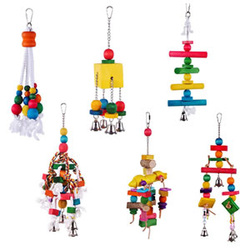
Be sure your bird has lots of interesting toys. Some birds are afraid of new toys. If this happens, the best thing to do is to show the bird the new toy, but don’t put it inside the cage, just set it down near the cage. Every time you have the chance, pick the toy up and show it to your bird and tell your bird how neat this new toy is. After a few days, try hanging the toy on the outside of the cage, down low. Move the toy into the cage when you feel the bird is no longer afraid of it. Be sure to rotate your bird’s toys so they can experience variety. If the bird has a favorite, then leave that one, but replace the others. Get toys of different types, textures and colors. Foraging toys are also good.
Your Bird's Diet
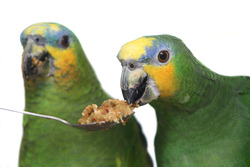
What do you feed a parrot? Not just seed and water! The best setup for your bird is to have 3 dishes: one for a seed mix, one for water, and one for fruit, vegetables, miscellaneous treats and table food. You should give your bird fresh food every day. We recommend Premium Seed Mixes which have seed, pellets, fruit and nuts. We also recommend adding a powdered vitamin and mineral supplement, Super Preen, for all birds. Super Minee Calcium supplement should also be given for African Grey Parrots, Toucans, birds which are molting and all egg laying birds.
Instead of filling the seed mix dish all the way to the brim, try to give your bird only as much feed as it will eat in one day. The water dish must be cleaned thoroughly with soap and hot water every day and sometimes twice a day if soiled with food or feces. OMAR'S does not recommend the use of water tubes because they can promote bacteria if not cleaned often enough, causing illness. If you use a water tube, purchase a brush that you can clean it with, and be sure to wash the tube daily with soap and hot water.
Every day you should serve your bird a variety of fruits, vegetables and treats. We thoroughly rinse off and serve all fresh fruits and vegetables raw. The bird will get more nutrients if raw. If you serve cooked or even thawed frozen fruits and vegetables, they spoil much quicker, so make sure you remove them after an hour or so.
When it comes to offering food to your bird, it is important to be creative. Try clipping veggies and fruits to the side of the cage in or around a play area. Weave greens through the bars of the cage for fun nibbling. Many bird owners have found this very useful for birds that will not touch fruits and veggies in their dishes. Chucks of corn on the cob can also be a favorite. Many birds enjoy not only the corn but gnawing on the cob as well. Many birds love brightly colored foods, as they seem more appealing. Try mixing yellow, orange, and red fruits and veggies in bite sizes together in a dish. When offering your exotic bird greens, it is best to wash them first and then hang the wet leaves in the cage. The water left on the leafy veggies is very attractive and can make your bird more prone to testing. You can also take a nibble of the food you are offering. Many times if your bird sees you eating a particular food he or she will want it now too. Feeding other people in the home and making a big fuss over the food will be all your bird needs to want some. You bird could also enjoy fresh seed just sprouted, as well. These are an excellent source of nutrients and can make the transition from seeds to leaves easier as well.
Remember to also pick up the wet food from the floor of the cage too. If you are serving dinner and wish to share cooked foods with your bird, pick up what's left over in its cage when you clear off the table. Try our Mom's Healthy Snack Mix as a treat and Mom's Nutty Noodle as a cooked food treat. If your bird does not like different foods, there are creative ways to introduce them, such as a stainless steel skewer where you hang the fruit rather than put it in the dish. Some smaller birds will try some new foods if you sprinkle egg food on it.
Here is a partial list of the fruits, vegetables and “table foods” you may try serving your bird: Apples, Oranges, Honeydew Corn, Yams, Bell Peppers, Papaya, Cantaloupe, Raspberries, Cauliflower, Chili Peppers, Pears, Apricots, Spinach, Bok Choy, Sweet Potatoes, Pineapple, Kiwi, Grapes, Broccoli, Beans, Cranberries, Bananas, Peaches Cucumber, Peas, Green Beans, Plums, Mango, Blueberries, Carrots, Sprouts, Cooked Rice, Cooked Beans, Cooked Squash, Mashed Potatoes, Macaroni & Cheese, Wheat Bread, Scrambled Eggs(with shell)
Instead of filling the seed mix dish all the way to the brim, try to give your bird only as much feed as it will eat in one day. The water dish must be cleaned thoroughly with soap and hot water every day and sometimes twice a day if soiled with food or feces. OMAR'S does not recommend the use of water tubes because they can promote bacteria if not cleaned often enough, causing illness. If you use a water tube, purchase a brush that you can clean it with, and be sure to wash the tube daily with soap and hot water.
Every day you should serve your bird a variety of fruits, vegetables and treats. We thoroughly rinse off and serve all fresh fruits and vegetables raw. The bird will get more nutrients if raw. If you serve cooked or even thawed frozen fruits and vegetables, they spoil much quicker, so make sure you remove them after an hour or so.
When it comes to offering food to your bird, it is important to be creative. Try clipping veggies and fruits to the side of the cage in or around a play area. Weave greens through the bars of the cage for fun nibbling. Many bird owners have found this very useful for birds that will not touch fruits and veggies in their dishes. Chucks of corn on the cob can also be a favorite. Many birds enjoy not only the corn but gnawing on the cob as well. Many birds love brightly colored foods, as they seem more appealing. Try mixing yellow, orange, and red fruits and veggies in bite sizes together in a dish. When offering your exotic bird greens, it is best to wash them first and then hang the wet leaves in the cage. The water left on the leafy veggies is very attractive and can make your bird more prone to testing. You can also take a nibble of the food you are offering. Many times if your bird sees you eating a particular food he or she will want it now too. Feeding other people in the home and making a big fuss over the food will be all your bird needs to want some. You bird could also enjoy fresh seed just sprouted, as well. These are an excellent source of nutrients and can make the transition from seeds to leaves easier as well.
Remember to also pick up the wet food from the floor of the cage too. If you are serving dinner and wish to share cooked foods with your bird, pick up what's left over in its cage when you clear off the table. Try our Mom's Healthy Snack Mix as a treat and Mom's Nutty Noodle as a cooked food treat. If your bird does not like different foods, there are creative ways to introduce them, such as a stainless steel skewer where you hang the fruit rather than put it in the dish. Some smaller birds will try some new foods if you sprinkle egg food on it.
Here is a partial list of the fruits, vegetables and “table foods” you may try serving your bird: Apples, Oranges, Honeydew Corn, Yams, Bell Peppers, Papaya, Cantaloupe, Raspberries, Cauliflower, Chili Peppers, Pears, Apricots, Spinach, Bok Choy, Sweet Potatoes, Pineapple, Kiwi, Grapes, Broccoli, Beans, Cranberries, Bananas, Peaches Cucumber, Peas, Green Beans, Plums, Mango, Blueberries, Carrots, Sprouts, Cooked Rice, Cooked Beans, Cooked Squash, Mashed Potatoes, Macaroni & Cheese, Wheat Bread, Scrambled Eggs(with shell)
Navigate: Our Services, Payment and shipping, About us, Reach us, Testimonial, News on Media
Access: Currently Available, Pet Books, Pet Posters, Pet accessories and toys, Photo Gallery, Pets show pictures
Articles: Birds as Pets, Reptiles as pets, Small animals as pets, Advantages of companion pets, How to teach children to care for pets, Law of the land (Indian Wildlife Protection Act 1972), Apartment pets, Sell your pets.
Access: Currently Available, Pet Books, Pet Posters, Pet accessories and toys, Photo Gallery, Pets show pictures
Articles: Birds as Pets, Reptiles as pets, Small animals as pets, Advantages of companion pets, How to teach children to care for pets, Law of the land (Indian Wildlife Protection Act 1972), Apartment pets, Sell your pets.
